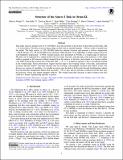| dc.contributor.author | Wright, Melvyn | |
| dc.contributor.author | Bally, John | |
| dc.contributor.author | Hirota, Tomoya | |
| dc.contributor.author | Miller, Kyle | |
| dc.contributor.author | Harding, Tyler | |
| dc.contributor.author | Colleluori, Keira | |
| dc.contributor.author | Ginsburg, Adam | |
| dc.contributor.author | Goddi, Ciriaco | |
| dc.contributor.author | McGuire, Brett | |
| dc.date.accessioned | 2022-03-10T15:55:04Z | |
| dc.date.available | 2022-03-10T15:55:04Z | |
| dc.date.issued | 2022-01-01 | |
| dc.identifier.uri | https://hdl.handle.net/1721.1/141114 | |
| dc.description.abstract | <jats:title>Abstract</jats:title>
<jats:p>This paper analyses images from 43 to 340 GHz to trace the structure of the Source I (SrcI) disk in Orion-KL with ∼12 au resolution. The data reveal an almost edge-on disk with an outside diameter ∼100 au, which is heated from the inside. The high opacity at 220–340 GHz hides the internal structure and presents a surface temperature ∼500 K. Images at 43, 86 and 99 GHz reveal structure within the disk. At 43 GHz there is bright compact emission with brightness temperature ∼1300 K. Another feature, most prominent at 99 GHz, is a warped ridge of emission. The data can be explained by a simple model with a hot inner structure, seen through cooler material. A wide-angle outflow mapped in SiO emission ablates material from the interior of the disk, and extends in a bipolar outflow over 1000 au along the rotation axis of the disk. SiO <jats:italic>v</jats:italic> = 0, <jats:italic>J</jats:italic> = 5–4 emission appears to have a localized footprint in the warped ridge. These observations suggest that the ridge is the working surface of the disk, and heated by accretion and the outflow. The disk structure may be evolving, with multiple accretion and outflow events. We discuss two sources of variability: (1) variable accretion onto the disk as SrcI travels through the filamentary debris from the Becklin–Neugebauer Object-SrcI encounter ∼550 yr ago; and (2) episodic accretion from the disk onto the protostar, which may trigger multiple outflows. The warped inner-disk structure is direct evidence that SrcI could be a binary experiencing episodic accretion.</jats:p> | en_US |
| dc.language.iso | en | |
| dc.publisher | American Astronomical Society | en_US |
| dc.relation.isversionof | 10.3847/1538-4357/ac391b | en_US |
| dc.rights | Creative Commons Attribution 4.0 International license | en_US |
| dc.rights.uri | https://creativecommons.org/licenses/by/4.0/ | en_US |
| dc.source | The American Astronomical Society | en_US |
| dc.title | Structure of the Source I Disk in Orion-KL | en_US |
| dc.type | Article | en_US |
| dc.identifier.citation | Wright, Melvyn, Bally, John, Hirota, Tomoya, Miller, Kyle, Harding, Tyler et al. 2022. "Structure of the Source I Disk in Orion-KL." The Astrophysical Journal, 924 (2). | |
| dc.contributor.department | Massachusetts Institute of Technology. Department of Chemistry | |
| dc.relation.journal | The Astrophysical Journal | en_US |
| dc.eprint.version | Final published version | en_US |
| dc.type.uri | http://purl.org/eprint/type/JournalArticle | en_US |
| eprint.status | http://purl.org/eprint/status/PeerReviewed | en_US |
| dc.date.updated | 2022-03-10T15:50:56Z | |
| dspace.orderedauthors | Wright, M; Bally, J; Hirota, T; Miller, K; Harding, T; Colleluori, K; Ginsburg, A; Goddi, C; McGuire, B | en_US |
| dspace.date.submission | 2022-03-10T15:50:57Z | |
| mit.journal.volume | 924 | en_US |
| mit.journal.issue | 2 | en_US |
| mit.license | PUBLISHER_CC | |
| mit.metadata.status | Authority Work and Publication Information Needed | en_US |
